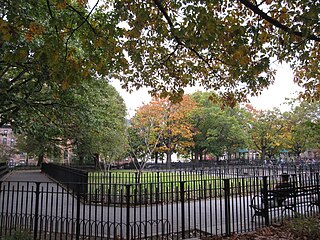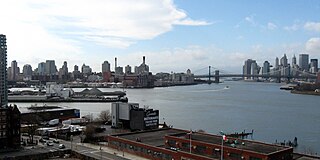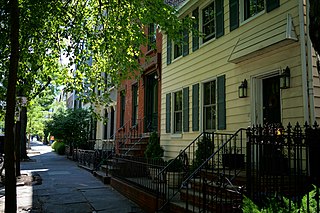
Clinton Hill is a neighborhood in north-central Brooklyn, a borough of New York City. It is bordered by the Brooklyn Navy Yard and the Brooklyn-Queens Expressway to the north, Williamsburg to the northeast, Classon Avenue and Bedford–Stuyvesant to the east, Atlantic Avenue and Prospect Heights to the south and southwest and Vanderbilt Avenue and Fort Greene to the west.

Cobble Hill is a neighborhood in the northwestern portion of the New York City borough of Brooklyn. A small neighborhood comprising 40 blocks, Cobble Hill sits adjacent to Brooklyn Heights to the north, Boerum Hill to the east, Carroll Gardens to the south, and the Columbia Street Waterfront District to the west. It is bounded by Atlantic Avenue (north), Court Street (east), Degraw Street (south) and the Brooklyn Queens Expressway (west). Other sources add to the neighborhood a rectangle bounded by Wyckoff Street on the north, Hoyt Street on the east, Degraw Street on the south, and Court Street on the west.

Fulton Ferry is a small area adjacent to Dumbo in the New York City borough of Brooklyn. The neighborhood is named for the Fulton Ferry, a prominent ferry line that crossed the East River between Manhattan and Brooklyn, and is also the name of the ferry slip on the Brooklyn side. The neighborhood is part of Brooklyn Community District 2.

William Bunker Tubby was an American architect who was particularly notable for his work in New York City.

Ditmas Park is a historic district in the neighborhood of Flatbush in Brooklyn, New York City. The traditional boundaries of Ditmas Park, including Ditmas Park West, are Ocean Avenue and greater Flatbush to the east, Dorchester Road and the Prospect Park South neighborhood to the north, Coney Island Avenue and the Kensington neighborhood to the west, and Newkirk Avenue to the south. Ditmas Park is patrolled by the New York City Police Department's 70th Precinct, and is within Brooklyn Community District 14. The New York City Subway's B and Q trains serve Ditmas Park.

Wallabout Bay is a small body of water in Upper New York Bay along the northwest shore of the New York City borough of Brooklyn, between the present Williamsburg and Manhattan Bridges. It is located opposite Corlear's Hook in Manhattan, across the East River to the west. Wallabout Bay is now the site of the Brooklyn Navy Yard.

The Center for Brooklyn History is a museum, library, and educational center founded in 1863 that preserves and encourages the study of Brooklyn's 400-year history. The center's Romanesque Revival building, located at Pierrepont and Clinton Streets in Brooklyn Heights, was designed by George B. Post and built in 1878-81, is a National Historic Landmark and part of New York City's Brooklyn Heights Historic District. The CBH houses materials relating to the history of Brooklyn and its people, and hosts exhibitions which draw over 9,000 members a year. In addition to general programming, the CBH serves over 70,000 public school students and teachers annually by providing exhibit tours, educational programs and curricula, and making its professional staff available for instruction and consultation.
The National Register of Historic Places listings in Syracuse, New York are described below. There are 111 listed properties and districts in the city of Syracuse, including 19 business or public buildings, 13 historic districts, 6 churches, four school or university buildings, three parks, six apartment buildings, and 43 houses. Twenty-nine of the listed houses were designed by architect Ward Wellington Ward; 25 of these were listed as a group in 1996.

Wallabout is a neighborhood in the New York City borough of Brooklyn that dates back to the 17th century. It is one of the oldest areas of Brooklyn, in the area that was once Wallabout Bay but has largely been filled in and is now the Brooklyn Navy Yard.

There are 73 properties listed on the National Register of Historic Places in Albany, New York, United States. Six are additionally designated as National Historic Landmarks (NHLs), the most of any city in the state after New York City. Another 14 are historic districts, for which 20 of the listings are also contributing properties. Two properties, both buildings, that had been listed in the past but have since been demolished have been delisted; one building that is also no longer extant remains listed.

The Lefferts-Laidlaw House is a historic villa located in the Wallabout neighborhood of Brooklyn in New York City, United States. Built around 1840, the house is a two-story frame building in the temple-fronted Greek Revival style.

Rockwood Chocolate Factory Historic District is a historic industrial complex and national historic district in Fort Greene, Brooklyn, New York City. The complex consists of 16 contributing buildings built between 1891 and 1928 and owned by Rockwood & Company until it went out of business in 1957. The largest and oldest building dates to 1891 and is located at the corner of Washington and Park avenues. It is a five-story, Romanesque Revival style building. Much of the complex has been converted to loft apartments.

The Cobble Hill Historic District is a municipal and national historic district located in the Cobble Hill neighborhood of Brooklyn, New York City. The national district consists of 796 contributing, largely residential buildings built between the 1830s and 1920s. It includes fine examples of Greek Revival, Italianate, and Queen Anne style row houses. Also in the district are a number of notable churches, including ones by Richard Upjohn and Minard Lafever, 1851–52). A number of early 20th century apartment buildings are part of the district as well.
This is a timeline and chronology of the history of Brooklyn, New York. Brooklyn is the most populous of New York City's boroughs, and was settled in 1646.

Scottholm is an historic housing development in the Meadowbrook neighborhood of Syracuse, Onondaga County, New York. It has been registered as a National Historic District. It is bounded by Salt Springs Road on the north; Brookford Road and East Avenue on the east; Meadowbrook Drive on the south; and Scottholm Terrace on the west. Scottholm consists of single‐family homes of varying styles built in the early 20th century. When it was built, Scottholm was marketed to upper middle class and upper class residents. Today, the area attracts a diverse population of white collar, academic, and creative class professionals. Nottingham High School, in the Syracuse City School District, is nearby.

Market Square Historic District is a national historic district located in the Black Rock neighborhood of Buffalo in Erie County, New York. The district encompasses 15 contributing buildings and 1 contributing site in a mixed residential and commercial section of Buffalo. The district developed between about 1830 and 1912, and includes a buildings in a variety of architectural styles including Federal, Gothic Revival, Italianate, Queen Anne, Romanesque Revival, and Bungalow / American Craftsman. Located in the district is the separately listed St. Francis Xavier Roman Catholic Parish Complex. Other notable contributing resources include the Market Square (1830), Black Rock Savings and Loan (1870-1910), Firehouse Engine #15 (1912), Smith House and Tavern, St. John's Church (1894), and Howell House and Store.

Watkins Glen Commercial Historic District is a national historic district located at Watkins Glen in Schuyler County, New York. It encompasses 33 contributing buildings in the central business district of Watkins Glen. It developed between about 1844 and 1939 and includes notable examples of Greek Revival, Italianate, Classical Revival, Colonial Revival, Second Empire and Romanesque Revival style architecture. Notable buildings include the Watkins Glen Municipal Building (1939), Watkins Glen Fire Station (1935), Watkins State Bank (1911), Hotel Kendall (1891), Haring Building (1844), former Watkins Post Office (1905), Freer Opera House, and the Durand Block (1897).

Rockland Road Bridge Historic District is a national historic district located at Piermont in Rockland County, New York. The district encompasses 12 contributing buildings and 8 contributing structures in the village of Piermont. It developed between about 1785 and 1940, and includes representative examples of Federal, Greek Revival, Italianate, and Second Empire style architecture. Located in the district are the separately listed William Ferdon House, Haddock's Hall, and the Rockland Road Bridge. Other notable buildings and structures include the Sparkill Pump House and Dam, "Protection Engine Company", and The Mine Hole.

Wallabout Industrial Historic District is a national historic district located in the Wallabout neighborhood of Brooklyn, Kings County, New York. The district encompasses 43 contributing buildings and 3 contributing sites in an industrial section of Brooklyn. The district developed in the late-19th and early-20th century and features noteworthy examples of Romanesque Revival style architecture. The buildings are largely constructed of brick, bluestone, and brownstone with limestone, terra cotta, and cast iron elements. The district includes the Rockwood & Company chocolate factory complex previously listed as part of the Rockwood Chocolate Factory Historic District. A number of the buildings have been adapted for residential and commercial uses.

Crown Heights North Historic District is a national historic district located in the Crown Heights neighborhood of Brooklyn, Kings County, New York. The district encompasses 1,019 contributing buildings in a predominantly residential section of Brooklyn. The district features noteworthy examples of Greek Revival, Gothic Revival, Italianate, Second Empire, Queen Anne, Romanesque Revival, Renaissance Revival, Beaux-Arts, and Colonial Revival style architecture. It largely developed between about 1853 and 1942, and consists of densely constructed rowhouses, townhouses, two-family houses, semi-attached houses, freestanding houses, flats, apartment buildings, and institutional and commercial buildings.























